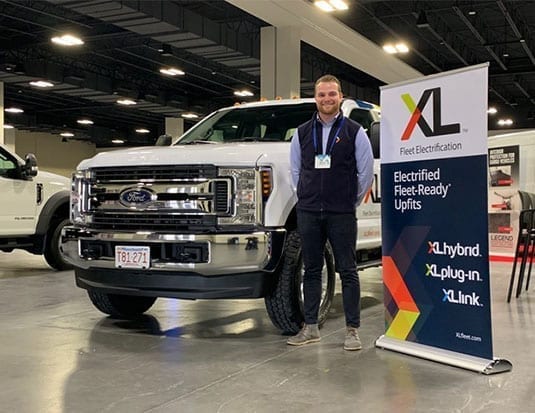XL Fleet converts commercial fleet vehicles into hybrids and plug-in hybrids.
XL Fleet, founded by MIT engineers and green energy veterans, is a U.S.-based company that provides simple and sustainable electrification solutions for Classes 2-6 commercial and municipal vehicles. The company has partnered with OEMs, like Ford, GM, and Isuzu, to turn their trucks into hybrid and plug-in hybrid vehicles, like the F-150, Chevrolet Express Vans, box trucks, really small buses, Ford Stripped Chassis, and most recently the F-250. This electrification process has effectively helped customers to save over one million gallons (3 million litres) of fuel and eliminate over 13,000 metric tons of CO2 emissions.
“The advantage of our system is that it’s an aftermarket technology. So, it does not disrupt the native internal combustion engine of the vehicle, it doesn’t disrupt the factory warranties or the services schedules, and it doesn’t require you to change a lot of your operations or anything like that,” said Eric Foellmer, Director of Marketing, XL Fleets.
Adding options for fleets
Initially, the company only produced hybrid vehicles, meaning that their consumer base is primarily those who asked for an upgrade to a hybrid system. The hybrid car provides a 25% boost on the miles per gallon (litres per kilometres) rating for trucks with a 20% reduction in CO2 emissions. Last year, though, they decided to introduce the plug-in hybrid as well, starting with the Ford F-150 truck. XL Fleets will also be releasing the plug-in hybrid version of the Ford F-250 Super-Duty truck, which will be shipping towards the end of the year.
“The industry, in general, is headed towards an all-electric [future] or becoming more electrified in its propulsion system. It’s been our goal since day one to always be viable without incentives, and today, you cannot buy an all-electric vehicle without incentives. Because the battery costs are so expensive, [customers] depend on incentives to be able to purchase those type of vehicles,” said Foellmer. “That model is slowly shifting, and we’re starting to see more of a charging infrastructure being developed. We’re seeing more customers have charging stations at their facilities, and we’re seeing more customers clamoring for vehicles that are plug-in. So, it was the right time for us to introduce a series of plug-in vehicles.”
According to Foellmer, the plug-in hybrid vehicles have been “fantastically popular” especially with municipalities like cities, townships and state governments, who try to meet their sustainability targets. This version offers a 50% mpg (l/km) improvement with a 33% reduction in CO2 emissions.
As easy as pie
The installation process is considerably easy, taking less than a day to install the hybrid or plug-in hybrid options into the vehicles.
“The only thing that we change on the OEM vehicle is that we remove the original factory driveshaft and we put an electric motor in between two smaller versions of that driveshaft. Then we help to propel the vehicles by adding an electric assist into the rear axle drive shaft. When the driver hits the gas, our electric motor kicks in and helps to propel the vehicle. So, you’re burning less gas and emitting less carbon dioxide as a result,” explains Foellmer.
Foellmer also states that most often they deal with new vehicle purchases. A fleet manager or customer will buy a new vehicle from the Ford, GM or Isuzu dealerships or a fleet management company, specify which system they would like to have on it, along with any additional accessories, and then send the car off to a professional third-party upfitter to install the systems. Afterward, the car gets delivered back to the customer.
The cost for the conversion to either one of these systems varies depending on the specific vehicle configurations. For the hybrid system, the range is between $13,000 and $15,000 on top of the vehicle’s original cost. For a plug-in hybrid system, the price increases to around $25,000 to $27,000 added to the vehicle’s purchase value. Both systems come with an additional warranty.
“Any Ford, GM or Isuzu vehicle warranties that are in place already remain intact. And then our system – the motor, the battery, the software, some connecting wiring, and everything else – is warranted by us for three years and 75,000 miles (120,700 km). There are extended warranties on that as well,” says Foellmer.
The link between the company and customers
The onboard telematics program monitors XL Fleets systems, XL Link, that provides the company with data that track things like how much CO2 emissions have reduced, mpg ratings, and the overall performance of the vehicles. However, that data cannot yet be accessed by the customers directly. XL Fleets hope to upgrade that program to be more customer-facing.
“We’re building a software system now that will allow the customer to access that data, but today it’s just something that we manage internally. [With this program] we can help customers get the most value out of their investment,” concludes Foellmer.



